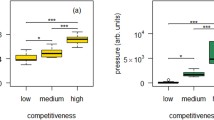Abstract
In the process of pedestrians’ evacuation from buildings, when an exit consists of two same-sized doors, with the same travel distance requirements, would the usage of doors be optimized by pedestrians? In this article, the imbalanced door choice of evacuees was investigated through experiment and modeling. The flow and crowd density in the exit zone during the announced evacuation drill was measured. It was found that the two doors were not used evenly by analyzing the number of passing people, especially when the instantaneous outflow was medium. Furthermore, to understand the specific behavior, the evacuation was reproduced by using a modified social force model, in which evacuees can move to and choose the doors randomly. As a key parameter in the dynamical model that needs to be calibrated, the desired velocity of evacuees, which ranges from 1.4 m/s to 2.0 m/s, were examined. The simulation results are in agreement with the experimental results on the imbalanced door choice pattern and other relevant factors. Moreover, discussion was conducted on the effect of imbalanced door choice on instantaneous velocity.








Similar content being viewed by others
References
Hoogendoorn S, Bovy P (2003) Simulation of pedestrian flows by optimal control and differential games. Optim Control Appl Methods 24(3):153–172
Helbing D, Farkas I, Vicsek T (2000) Simulating dynamical features of escape panic. Nature 407(6803):487–490
Alizadeh R (2010) A dynamic cellular automaton model for evacuation process with obstacles. Saf Sci 49(2):315–323
Kuang H, Song T, Li XL, Dai SQ (2008) Subconscious effect on pedestrian counter flow. Chin Phys Lett 25(4):1498–1501
Yu W, Johansson A (2007) Modeling crowd turbulence by many-particle simulations. Phys Rev E 76(4):046105–046155
Moussaïd M, Helbing D, Theraulaz G (2011) How simple rules determine pedestrian behavior and crowd disasters. Proc Natl Acad Sci 108(17):6884–6888
Chraibi M, Seyfried A, Schadschneider A (2010) Generalized centrifugal-force model for pedestrian dynamics. Phys Rev E 82(4):046111
Baglietto G, Parisi DR (2011) Continuous-space automaton model for pedestrian dynamics. Phys Rev E 83(5):056117
Parisi D, Dorso C (2007) Why “faster is slower” in evacuation process. In: Pedestrian and evacuation dynamics 2005, Springer, Berlin, pp 341–346
Seyfried A, Steffen B, Lippert T (2006) Basics of modelling the pedestrian flow. Phys A Stat Mech Appl 368(1):232–238
Zheng X, Zhong T, Liu M (2009) Modeling crowd evacuation of a building based on seven methodological approaches. Build Environ 44(3):437–445
Fang Z, Song W, Zhang J, et al. (2010) Experiment and modeling of exit-selecting behaviors during a building evacuation. Phys A Stat Mech Appl 389(4):815–824
Zhao D, Yang L, Li J (2006) Exit dynamics of occupant evacuation in an emergency. Phys A Stat Mech Appl 363(2):501–511
Varas A, Cornejo MD, Mainemer D et al. (2007) Cellular automaton model for evacuation process with obstacles. Phys A Stat Mech Appl 382(2):631–642
Nelson HE, Mowrer FW (2002) Emergency movement. In: DiNenno PJ et al (ed) The SFPE handbook of fire protection engineering, 3rd edn. Society of fire protection engineers, Bethesda, pp 3-367–3-380
Acknowledgments
The study was jointly supported by National Basic Research Program of China (973 Program, Grant No. 2012CB719702); National Natural Science Foundation of China (91024025) and the Research Grant Council of Government of the Hong Kong Administrative Region (No. CityU119011).
Author information
Authors and Affiliations
Corresponding author
Rights and permissions
About this article
Cite this article
Mu, H., Lo, S., Song, W. et al. An Experimental and Numerical Study of Imbalanced Door Choice During an Announced Evacuation Drill. Fire Technol 52, 801–815 (2016). https://doi.org/10.1007/s10694-015-0503-0
Received:
Accepted:
Published:
Issue Date:
DOI: https://doi.org/10.1007/s10694-015-0503-0



